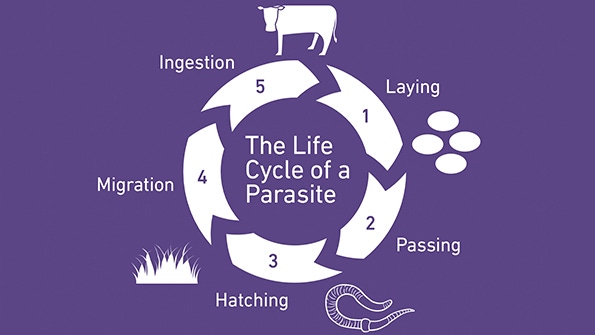Welcome to Health Ranch, where you can find information and resources to help you put the health and well-being of your cattle at the top of the priority list.
Facing internal parasites head-on
Do you have a basic understanding of internal parasite biology and control measures? It's the first step cattlemen can take to ensure a return on their investment in a parasite control program and reduce the impact of anthelmintic resistance.
November 1, 2016

Sponsored Content
Controlling internal parasites is a proven practice to improve performance in various stages of cattle production, while also giving you a significant return on investment — and in most cases, greater than any other management practice.1
“Parasites are getting worse every day, and it’s becoming more difficult to combat them,” says Dr. Jody Wade, Professional Services Veterinarian, Boehringer Ingelheim Animal Health USA, Inc. “There is increasing concern about the resistance of cattle parasites to dewormers [anthelmintic resistance] and the ability of cattlemen to continue to have cost-effective parasite control.”2
Getting a basic understanding of internal parasite biology and control measures is the first step cattlemen can take to ensure a return on their investment in a parasite control program and reduce the impact of anthelmintic resistance.
The basics of parasitology
Adult parasites live in the gastrointestinal tract of cattle, and they then lay eggs that are expelled from the cattle through feces. The eggs hatch and develop into infected larvae. The infected larvae crawl onto the grass and are ingested when cattle graze. The larvae then develop into adults in the gastrointestinal tract and lay more eggs.3
“There are a number of factors involved in determining the severity of parasite problems on your ranch each year,” explained Dr. Wade. “Rainfall amounts, environmental temperatures, pasture type, grazing management, age and immune status of the cattle, the previous treatment used, and resistance patterns are all things that need to be considered when choosing the right dewormer.”
Anthelmintic resistance
When you under-dose or too frequently dose the opportunity for worms to build resistance increases. “Repeated exposure to a dewormer at a low dose promotes resistance. This practice is often seen when pour-on dewormers are repeatedly used at low doses for fly control only. Under-dosing occurs when too little product is administered. Recommended dosage can vary from one animal to the next based on their weight. Not delivering a high enough dose based on their weight increases the odds of parasites resistance,” explains Wade.
“In a closed population, if you treat too frequently, the remaining worms are the only ones left to breed,” he said. “Resistance increases with each generation. And if less than the labeled dose is given, this leaves too many survivors to pass on their resistance genes to the next generation.”
Work with your veterinarian to establish a resistance management program in your herd. First, conduct a fecal egg count reduction test to detect if you have parasite resistance in your herd. Two tests are taken; after the first test, treat according to your veterinarian’s recommendation; then, come back in 14 days to take another count, and then calculate the loss.
“Do this test on 20 percent of your herd, or 20 animals, whichever is fewer,” Wade added. “We want to see a 90 to 95 percent fecal egg production reduction.” Less than that would suggest a resistance population is present.
Secondly, herd managers should consider a coproculture. A coproculture provides added value to the diagnosis, with identification of parasite species involved. The samples are incubated and then evaluated by a parasitologist to determine the composition of the nematode population.
With the help of this information, cattle producers can determine the most effective program that will minimize the risk of resistance. To accomplish this, Wade recommended these steps:
Keep your veterinarian involved in your parasite management program.
Choose a dewormer with the greatest efficacy. Look at the active ingredient in the parasite control product because there are differences in persistence and efficacy. For example, Synanthic® (oxefendazole), demonstrated efficacy against major internal parasites including L4, inhibited L4 Ostertagia ostertagi and tapeworms.
Avoid under- or overdosing — follow label directions.
Quarantine, test and deworm animals before turning them out with the rest of the herd.
Rotate product chemistry according to your veterinarian’s advice.
Use strategic management practices such as good hygiene and rotation of pastures and/or animal species to reduce pasture contamination.
Of these steps, administering the full label dose is the most important, Wade says. “If you under-dose, it allows more resistant worms to survive, and each generation gets more and more resistant.”
Visit with your local veterinarian to establish an effective deworming program for the whole herd.
SYNANTHIC Residue Warnings: Cattle must not be slaughtered until 7 days after treatment. Because a withdrawal time in milk has not been established, do not use in female dairy cattle of breeding age.
References:
1 Stromberg BE, Vatthauer RJ, Schlotthauer JC, et al. Production responses following strategic parasite control in a beef cow/calf herd. Vet Parasitol 1997;68(4):315–322.
Antiparasitic resistance in cattle and small ruminants in the United States: How to detect it and what to do about it. FDA public meeting on antiparasitic drug use and resistance in ruminants and equines. Federal Drug Administration’s Center for Veterinary Medicine. Available at: www.fda.gov/animalveterinary/resourcesforyou/ucm318015.htm. Accessed Sept. 2, 2016.
3 Gadberry S, Pennington J, Powell J. Internal parasites in beef and dairy cattle. Available at: http://articles.extension.org/pages/11022/internal-parasites-in-beef-and-dairy-cattle#top. Accessed Sept. 2, 2016.
SYNANTHIC® is a registered trademark of Boehringer Ingelheim Animal Health USA Inc. ©2019 Boehringer Ingelheim Animal Health USA Inc., Duluth, GA. All Rights Reserved. JOB-US-BOV-0537
About the Author(s)
You May Also Like
